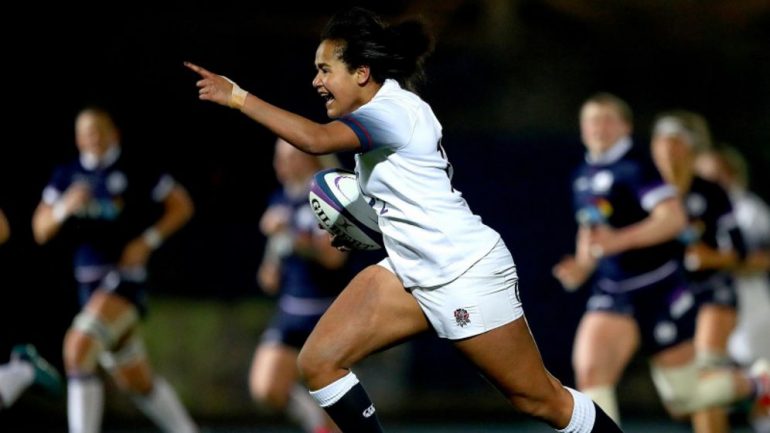Here is the full list of the first full-time professional women rugby players:
Zoe Aldcroft (Gloucester-Hartpury Womens RFC)
Sarah Beckett (Firwood Waterloo Ladies)
Sarah Bern (Bristol Bears Women)
Hannah Botterman (Saracens Women)
Jess Breach (Harlequins Ladies)
Jo Brown (Loughborough Lightning)
Shaunagh Brown (Harlequins Ladies)
Rachael Burford (Harlequins Ladies)
Rowena Burnfield (Richmond FC)*
Bryony Cleall (Saracens Women)*
Poppy Cleall (Saracens Women)
Amy Cokayne (Wasps FC Ladies)*
Vickii Cornborough (Harlequins Ladies)
Katy Daley-Mclean (Loughborough Lightning)
Lark Davies (Worcester Valkyries)
Abby Dow (Wasps FC Ladies)*
Vicky Fleetwood (Saracens Women)
Zoe Harrison (Saracens Women)
Tatyana Heard (Gloucester-Hartpury Womens RFC)
Natasha Hunt (Gloucester-Hartpury Womens RFC)
Sarah Hunter (Loughborough Lightning)
Justine Lucas (Loughborough Lightning)
Claudia Macdonald (Wasps FC Ladies)*
Sarah McKenna (Saracens Women)
Cath O’ Donnell (Loughborough Lightning)
Marlie Packer (Saracens Women)
Ellena Perry (Saracens Women)
Leanne Riley (Harlequins Ladies)
Emily Scarratt (Loughborough Lightning)
Abbie Scott (Harlequins Ladies)
Emily Scott (Harlequins Ladies)*
Kelly Smith (Gloucester-Hartpury Womens RFC)
Lydia Thompson (Worcester Valkyries
Lagi Tuima (Bristol Bears Women)
Carys Williams (Loughborough Lightning)
*Players on an EPS Agreement
These 35 names include the 7 asterisked players who will join the group for training sessions, but will not be part of the full-time squad.
In some detail:
The squad comprises 19 forwards and 16 backs. Many of the players are versatile: they can occupy different positions on the field. This is a vital asset in a World Cup, where test matches follow one another with alarming rapidity. One of the many advantages this professional status gives is to offer them plenty of time to work on the specialist requirements of those different positions.
Take for example the Cleall twins. Poppy has occupied four different positions in her relatively short international career, No 8, flanker, lock and even prop. Bryony, who will be delighted at her inclusion, is listed as a prop, but has spent most of her playing career in the back row.
The picture is similar for the backs: most selectors would dream of having Emily Scarratt playing at outside centre and full-back at one and the same moment. Sadly this remains an idle dream. But several of her team-mates can double up to make team selection that much less fraught.
You could divide these names into three groups: the racing certainties, the more-than-likelies and the overjoyed at finding favour. It is this last category that creates the most interest. they represent quite different types of player.
Among the senior figures are Rowena Burnfield and Emily Scott. Her fellow-players have no doubts about Burnfield’s strengths: ever reliable, always willing to do the hard grind on behalf of her fellows; since finishing her England 7s contract Scott has languished in a backwater. It’s excellent news that she is restored to favour at the highest level.
Then the players at the other end of the experience scale: no fewer than five of the Under 20 squad that completed a hat-trick of victories on tour in Canada last Autumn find themselves included: Abbie Dow, Zoe Harrison, Lagi Tuima, Sarah Beckett and Ellena Perry. The first three, all backs, were already full England caps; the other pair, both forwards, deserve huge congratulations for making this major step up. Tatyana Heard is another young player who has overcome major opposition to be selected. Centre is one area of great riches for the Red Roses at the moment.
This RFU announcement represents a huge boost for the 15s game over its increasingly thriving offspring 7s.
Then the questions that remain unanswered
How does this selection get altered over the next two-and-a-half years till the World Cup?
Is it significant that it has the words ‘for the 2019 season’ attached to them? That doesn’t sound very full-time.
If new contracts are to be allocated each season, then we return to the pattern that leading commentators like Catherine Spencer have pointed out with vigour: Can contracts be switched on and off like the table lamp? Are players to be placed on a switchback between an RFU contract and their job? Unlike male cricketers, they can’t fall back on a lower-paid county salary; the only option is to return to full-time employ. How easy is that going to be in the current economic climate?
If the squad doesn’t get altered, then the Red Roses will be the first players in sporting history not to undergo amendments over such a long period. New talent springs up with astonishing speed. Jess Breach and Ellie Kildunne were transformed almost overnight from hopeful youngsters into major international stars. Will their equally young successors in future seasons be given contracts or EPS agreements, and if so, who loses out?
At the elite level, it takes a lot to oust an established player. Occasionally the sensible thing is to switch positions: the great Safi N’Diaye was asked to move into the second row this season to allow for the burst of talent France had in the back row (Hermet, Annery, Ferer and Ménager). But there is versatility aplenty is this English squad.
There are three 6 Nations tournaments to come between now and the next World Cup. The risk the RFU runs is either: the contracted players will continue to be sure of their places for all that period, or England will not put out its strongest side when new talent arrives to dispute these prior claims.
When England’s venture at the 2020 Olympics is finally put to bed, what happens to the players most likely to be wanted for that World Cup a year later? How will players like Alex Matthews (two WRWC appearances already) and Ellie Kildunne be accommodated? Will the 7s contracts simply be renamed 15s contracts?
The Bare Bones
To get down to the bare bones of the matter: will this group be able to beat New Zealand and France any time they meet? Of course, other nations will be upping their game intensely over the intervening period. Canada and the USA are the most obvious candidates for toppling the apple-cart; Ireland and Australia are likely to provide a huge challenge. But the cream of the world’s players not already resident in Albion are to be found in the Hexagon and the Land of the White Cloud. And both proved too strong for England the last time they met.
Will this new full-time, full-term contract make the crucial difference? The players are in no doubt. Quite apart from the immense stimulus this gives the women’s game, the practical advantages are even more important. When the Red Roses competed at the last World Cup, most foreign commentators made a point of singling out this unique status they enjoyed – whether the journo’s nation lost to them or won. Yet those contracts had been in place for only a matter of months. Yes, it gave them a head-start in fitness and togetherness, but it didn’t stop the Black Ferns outplaying them in the last 40 minutes of the tournament.
Unfortunately for English hopes it’s more than likely that those leading rivals will be among the first to adopt the same or similar terms for their players. That at least will help to flatten out the playing area among the elite nations, even if it widens the gap between the paid and the unpaid.
The Here and Now
The 6 Nations begins in under a month. To that end the entire squad assembles this weekend at Bisham Abbey for a thorough initiation course. Everyone will be desperate for selection for the opening bout against Ireland at Energia Park (aka Donnybrook).
Whoever is selected will leave another twelve players on an imaginary support bench. Simon Middleton is almost certain to give everyone a run during this campaign. Only by the last round will he – and we – have a better idea of what a future batting order will look like. Exciting times.









